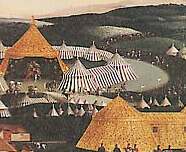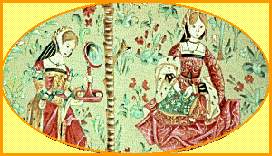|
DEFINITION
Hanging: Something, such as a tapestry, that is hung. The way in which
something hangs. from Old English hangian, to be suspended; syn: suspension,
dangling.
As suggests these definitions, a tapestry, considered as a hanging, does not have to be fixed rigidly but would have to hold out.
USE OF HANGING TAPESTRIES
The former use of the tapestries confirms this form of display. Indeed the
tapestries were intended to build closed and warn spaces in the large room of the
castles. Traveling they made it possible to simulate vertical walls inside the
vast tents of nobility and gentry. Laid out outside, as well for the
religious festivals, the tournaments or the princely meetings they even made it
possible to create small villages with its streets, its public and private
places. The most beautiful example of this last use was given at the time of
congress from 7 to June 24, 1520, known under the name of congress of
the field of the Gold Cloth (*)
(*) The negotiations of the Field of the Cloth of Gold is identified in two
pictures. The palate of Hampton Court, close to London, shelter the original. Of
an anonymous author of XVIth century, it is work of propaganda, all with the
glory of the English sovereign. A replica at identical, ordered in 1845 by
king of France Louis-Philippe to the painter Friedrich Bouterwerk, within the scope
of the first Entente Cordiale, is preserved at the castle of Azay le Rideau in Loire valley.

DISPLAY OF A TAPESTRY
Thus it was not conceivable, either it be putting up, displacement or
fitting up, that these tapestries be fixed on hard frame. For these various uses
one preferred to tighten a wire between two walls, between two posts and to hang
them on these wire at the manner of a linen to dry. In this way it was
easy also to maintain these hangings against dust, insects and the mould which
would not have failed to invade when the tapestry was so frequently and
naturally displayed on a wall.
Another reason so why a tapestry is not framed in
a rigid way holds with the Tapestry Art itself.
A tapestry tends to represent the nature of the things by their forms, their
instabilities, their colors and their reliefs. The materials used to made a
tapestry and the way in which it is exposed contribute together to depict. It is
obvious that a view of a foliage will have a more realistic playing if the
hanging forms by the reliefs of the textile structure itself, its drapery and
even if it seems to quiver with a draught. It is the same for hangings showing
battles, pastoral or ceremonial sceneries.
The playing of reliefs of the matterial and movements of the whole tapestry are
an absolutely essential characteristic of the tapestry art. The needle-worked
tapestry, a needlepoint on canvas is of comparable nature that the woven
tapestry. One can even advance that it develops more still the possibilities of
this Art by the greatest choice of stitches and materials at its disposal. So
the Tapestry or Needlepoint Art does not have to imitate or compete with
pictorial art. It has its own form of language and display which does not have
anything to envy from painting. The tapestry in its original form is œuvre
in relief, free and moving, in a word: alive!
Foregoing -
Summary -
Next
|
